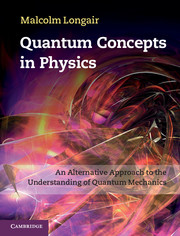Book contents
- Frontmatter
- Contents
- Preface
- Acknowledgements
- Part I The Discovery of Quanta
- Part II The Old Quantum Theory
- Part III The Discovery of Quantum Mechanics
- 10 The collapse of the old quantum theory and the seeds of its regeneration
- 11 The Heisenberg breakthrough
- 12 Matrix mechanics
- 13 Dirac's quantum mechanics
- 14 Schrödinger and wave mechanics
- 15 Reconcilingmatrix and wave mechanics
- 16 Spin and quantum statistics
- 17 The interpretation of quantum mechanics
- 18 The aftermath
- Epilogue
- Notes
- References
- Name index
- Subject index
18 - The aftermath
from Part III - The Discovery of Quantum Mechanics
Published online by Cambridge University Press: 05 February 2013
- Frontmatter
- Contents
- Preface
- Acknowledgements
- Part I The Discovery of Quanta
- Part II The Old Quantum Theory
- Part III The Discovery of Quantum Mechanics
- 10 The collapse of the old quantum theory and the seeds of its regeneration
- 11 The Heisenberg breakthrough
- 12 Matrix mechanics
- 13 Dirac's quantum mechanics
- 14 Schrödinger and wave mechanics
- 15 Reconcilingmatrix and wave mechanics
- 16 Spin and quantum statistics
- 17 The interpretation of quantum mechanics
- 18 The aftermath
- Epilogue
- Notes
- References
- Name index
- Subject index
Summary
We have reached the goal I set myself when this journey began. From about 1927 onwards, the quantum theory in its modern guise for non-relativistic quantum mechanics was essentially complete, although there remained problems of interpretation which took a number of years to unravel – some of them are still hotly debated. But much of the apparatus was already in place and the subsequent developments changed completely the face of physics. Jammer (1989) summarises the achievement as follows:
‘Since 1927, the development of quantum mechanics and its applications to molecular physics, to the solid state of matter, to liquids and gases, to statistical mechanics, as well as to nuclear physics, demonstrated the overwhelming generality of its methods and results. In fact, never has a physical theory given a key to the explanation and calculation of such a heterogeneous group of phenomena and reached such a perfect agreement with experience as has quantum mechanics.’
As noted by Mehra and Rechenberg (2001), the 1930s also saw the beginning of the compartmentalisation of physics into separate quantum disciplines. Thus, during the 1930s,with the general acceptance and success of quantum mechanics, the quantum physicists began to specialise in disciplines such as atomic physics, molecular physics, solid state physics, including metal and semiconductor physics, condensed matter physics and low temperature physics, while at high energies, nuclear, particle and cosmic ray physics developed as disciplines in their own right. Whereas the pioneers of quantum mechanics regarded the whole province of quantum physics as their domain, the various branches of quantum physics became fragmented into these specialisms, not so different from those encountered in any physics department today.
- Type
- Chapter
- Information
- Quantum Concepts in PhysicsAn Alternative Approach to the Understanding of Quantum Mechanics, pp. 368 - 387Publisher: Cambridge University PressPrint publication year: 2013



